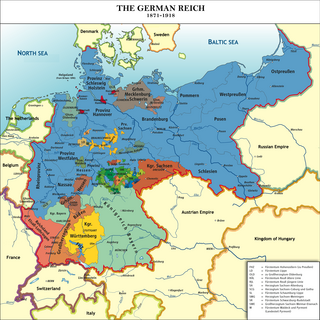
Katowice is the capital city of the Silesian Voivodeship in southern Poland and the central city of the Katowice urban area. As of 2021, Katowice has an official population of 286,960, and a resident population estimate of around 315,000. Katowice is a central part of the Metropolis GZM, with a population of 2.3 million, and a part of a larger Katowice-Ostrava metropolitan area that extends into the Czech Republic and has a population of around 5 million people, making it one of the most populous metropolitan areas in the European Union.

Upper Silesia is the southeastern part of the historical and geographical region of Silesia, located today mostly in Poland, with small parts in the Czech Republic. The area is predominantly known for its heavy industry.

The Upper Silesia plebiscite was a plebiscite mandated by the Versailles Treaty and carried out on 20 March 1921 to determine ownership of the province of Upper Silesia between Weimar Germany and Poland. The region was ethnically mixed with both Germans and Poles; according to prewar statistics, ethnic Poles formed 60 percent of the population. Under the previous rule by the German Empire, Poles claimed they had faced discrimination, making them effectively second class citizens. The period of the plebiscite campaign and inter-Allied occupation was marked by violence. There were three Polish uprisings, and German volunteer paramilitary units came to the region as well.

Ruch Chorzów is a Polish professional football club based in Chorzów, Upper Silesia. It is one of the most successful football teams in Poland, having won fourteen league titles, and the Polish Cup thrice. As of the 2024–25 season, they compete in the 1. liga, after suffering relegation from the 2023–24 Ekstraklasa.

Silesians is both an ethnic as well as a geographical term for the inhabitants of Silesia, a historical region in Central Europe divided by the current national boundaries of Poland, Germany, and Czechia. Historically, the region of Silesia has been inhabited by Polish, Czechs, and by Germans. Therefore, the term Silesian can refer to anyone of these ethnic groups. However, in 1945, great demographic changes occurred in the region as a result of the Potsdam Agreement leaving most of the region ethnically Polish and/or Slavic Upper Silesian. The Silesian language is one of the regional languages used in Poland alongside Polish as well as Kashubian and is structured with in a SVO format, however the grammar is quite often different to that of the other Lechitic languages. The names of Silesia in different languages most likely share their etymology—Polish: ; German: Schlesienpronounced[ˈʃleːzi̯ən] ; Czech: Slezsko ; Lower Silesian: Schläsing; Silesian: Ślōnsk ; Lower Sorbian: Šlazyńska ; Upper Sorbian: Šleska ; Latin, Spanish and English: Silesia; French: Silésie; Dutch: Silezië; Italian: Slesia; Slovak: Sliezsko; Kashubian: Sląsk. The names all relate to the name of a river and mountain in mid-southern Silesia, which served as a place of cult for pagans before Christianization.

The Province of Upper Silesia was a province of the Free State of Prussia from 1919 to 1945. It comprised much of the region of Upper Silesia and was eventually divided into two government regions called Kattowitz (1939–1945), and Oppeln (1819–1945). The provincial capital was Oppeln (1919–1938) and Kattowitz (1941–1945), while other major towns included Beuthen, Gleiwitz, Hindenburg O.S., Neiße, Ratibor and Auschwitz, added in 1941. Between 1938 and 1941 it was reunited with Lower Silesia as the Province of Silesia.

Ernest Otton Wilimowski, nicknamed "Ezi", was a footballer who played as a forward. He ranks among the best goalscorers in the history of both the Poland national team and Polish club football. After re-taking German citizenship following the invasion of Poland, he also played for the Germany national team.
AKS Chorzów is a sports club based in Chorzów, Poland. It is one of the earliest sports organizations in Upper Silesia and is still well known nationally for its football and handball teams. The club also made its mark on the international stage: Halina Richter-Górecka was part of the gold medal-winning women's 100m relay team at the 1964 Tokyo Olympic Games; tennis player Danuta Wieczorek appeared at Wimbledon as a junior.

1. FC Kattowitz was an ethnically German football club playing in what was Kattowitz, Silesia Province in Germany and was active during the inter-war period and World War II when the two countries struggled over control of the region. Established in 1905, the original club disappeared in 1945; a modern-day Polish club using the name 1. FC Katowice was formed in 2007.

The history of Katowice spans over 600 years.

Vorwärts-Rasensport Gleiwitz was a German association football club from the city of Gleiwitz, Upper Silesia, today Gliwice, Poland.

The Gauliga Schlesien was the highest football league in the region of Silesia (German:Schlesien), which consisted of the Prussian provinces of Lower Silesia and Upper Silesia from 1933 to 1945. Shortly after the formation of the league, the Nazis reorganised the administrative regions in Germany, and the Gau Silesia, later subdivided into Gau Upper Silesia and Gau Lower Silesia, replaced the Prussian provinces.

The Battle of (the) Annaberg was the biggest battle of the Silesian Uprisings. The battle, which took place between May 21–26, 1921, was fought at the Annaberg, a strategic hill near the village of Annaberg O.S., located southeast of Oppeln (Opole) in Upper Silesia, Weimar Germany. After the hill had been captured by irregular Polish-Silesian units in the Third Silesian Uprising, German Freikorps pushed the Polish forces back. The final border was determined by political and diplomatic efforts.
German Social Democratic Party was a political party in Poland, founded on March 26, 1922.

SC Diana Kattowitz was an ethnically German association football club playing in what was Kattowitz, Upper Silesia in Germany during the inter-war period. Established 13 February 1905, it was one of a small number of clubs that made up the Kattowitzer Ballspiel-Verband alongside Preussen Kattowitz and Germania Kattowitz. With FC 1903 Ratibor, these clubs formed the Upper Silesian division of the Southeast German Football Federation in 1906.

Preußen Hindenburg was a German association football club from the village of Zaborze, Upper Silesia in Germany.
Kattowitz is the German name for the Polish city of Katowice.
East Upper Silesia is the easternmost extremity of Silesia, the eastern part of the Upper Silesian region around the city of Katowice. The term is used primarily to denote those areas that became part of the Second Polish Republic on 20 June 1922, as a consequence of the post-World War I Treaty of Versailles. Prior to World War II, the Second Polish Republic administered the area as Autonomous Silesian Voivodeship. East Upper Silesia was also known as Polish (Upper) Silesia, and the German (Upper) Silesia was known as West Upper Silesia.

The South Eastern German football championship was the highest association football competition in the Prussian provinces of Silesia, which was divided into the Province of Lower Silesia and the Province of Upper Silesia after 1919, and Posen, which mostly became part of Poland in 1919. The competition was disbanded in 1933.

The Union of Upper Silesians was an early 20th-century movement for the independence of Upper Silesia. The movement had its genesis during the revolutions of 1848. Allied with the Silesian People's Party, it dissolved in 1924 but has influenced the present-day Silesian Autonomy Movement.















